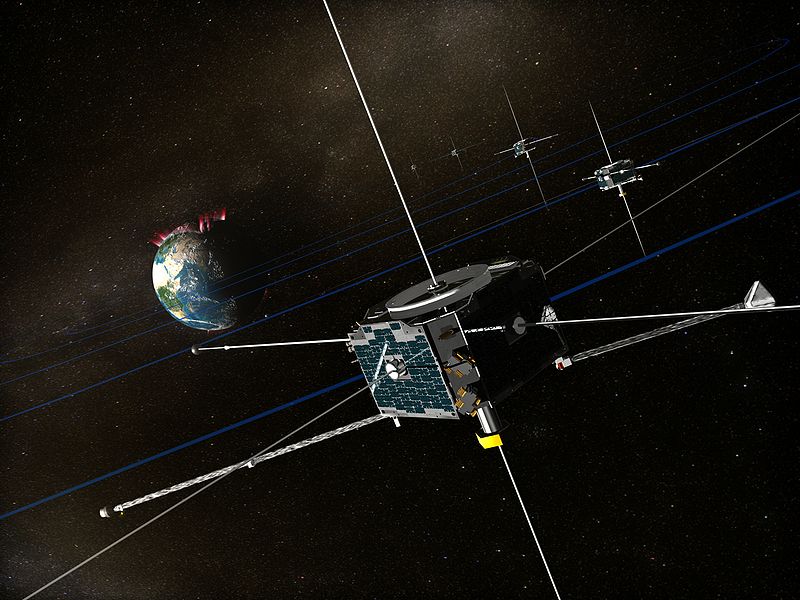This is according to data collected by the Themis spacecraft fleet. These are tremors reminiscent of earthquakes and are a significant factor in igniting the aurora borealis
Translation: user Darwin from the Rutter website. Courtesy of the Archery user.

NASA researchers, who used a fleet of five THEMIS space vehicles, discovered a type of weather in space reminiscent of earthquakes and is a significant factor in igniting the northern lights on Earth. They call the phenomenon "space-quakes".
A spacequake is a tremor in the Earth's magnetic field and is most strongly felt in the Earth's orbit around the Sun. The effect of the space tremor can reach the surface of the earth.
"Magnetic fluctuations have been detected at stations all over the planet in a similar way to the way seismic sensors measure strong earthquakes," says the THEMIS principal investigator.
This is an appropriate analogy, since "the total energy of a space quake can rival the energy of an earthquake of magnitude five or six on the Richter scale."
In 2007, THEMIS detected the early signs of space tremors. The process begins in the Earth's magnetic tail which is stretched like a wind sleeve by the solar wind moving at a speed of a million miles per hour. Sometimes the tail can be very tense. When the tail is stretched too much it snaps back like a rubber band that has been stretched too much. The plasma of the solar wind that was trapped in the tail, flew powerfully towards the earth.
On more than one occasion, the THEMIS spacecraft were "in the line of fire" when the "plasma jets" flew by. Clearly, the jets should have hit the Earth. But what happened then? The THEMIS fleet moves towards Earth to find out what happened. "Now we know - the plasma jets create space vibrations".
According to THEMIS, the jets crash into the geomagnetic field about 30 kilometers above the Earth's equator. The collision creates a reactive process, in which the plasma jumps up and down on the resonance of the magnetic field. Researchers call this: "repetitive flow rebuffing". This is similar to a tennis ball bouncing on a carpet. The first jump will be big, but after that the jumps will get smaller and smaller due to the energy absorbed by the carpet.
"For a long time we suspected that something like this was happening" says Sibek. "But, by directly observing the THEMIS discovered something new and surprising." The surprising thing is plasma vortices, huge eddies of magnetized gas, the width of the Earth itself, spinning at the edge of the Earth's quivering magnetic field.
"When the plasma jets hit the inner magnetosphere, vortices with the opposite direction of rotation repeatedly appear on both sides of the plasma jet. We believe that the eddies can create significant electrical currents in the immediate environment of the Earth.
In their joint action, the eddies and space vibrations can create effects that are felt on Earth. The tails of the eddies can channel particles into the atmosphere and thus create aurora as well as create ionization waves (waves that create ions) that can interfere with radio communications and GPS.
By pushing magnetic field surfaces, space vibrations create currents on the surface of the very sphere we walk on. Bursts of magnetic earth currents can cause serious consequences and even cause power outages by shutting down power grids over large areas. During the space quake, the Earth's magnetic field vibrates in a similar way to the vibrations of the beams during an earthquake.
After THEMIS discovered the vibrations, Joachim Bim from the National Laboratory in Los Alamos, New Mexico, created a computer simulation of the monitoring process. And indeed, the eddies in the simulation were consistent with THEMIS measurements. Furthermore, the simulation showed that it is probably possible to see the process of observations from the surface of the Earth in the form of small waves and eddies in displays of the northern lights. Ground stations confirm the issue with observations.
"It is a complex process but everything fits" says Sibek. The work is not finished yet. "We still have a lot to learn, like how big can space vibrations get? How many eddies can swirl around the earth at the same time? - And what is the interaction between the vortices?"


3 תגובות
There are processes called fusion in these processes the field lines merge and allow energy transitions in and out
1. Come up with a name that is suitable for a communication frog.
2. There is no system in which the magnetic flux lines open and close, it is physically impossible for the flux lines to always be closed.
What does Zeot mean vibrations in space?